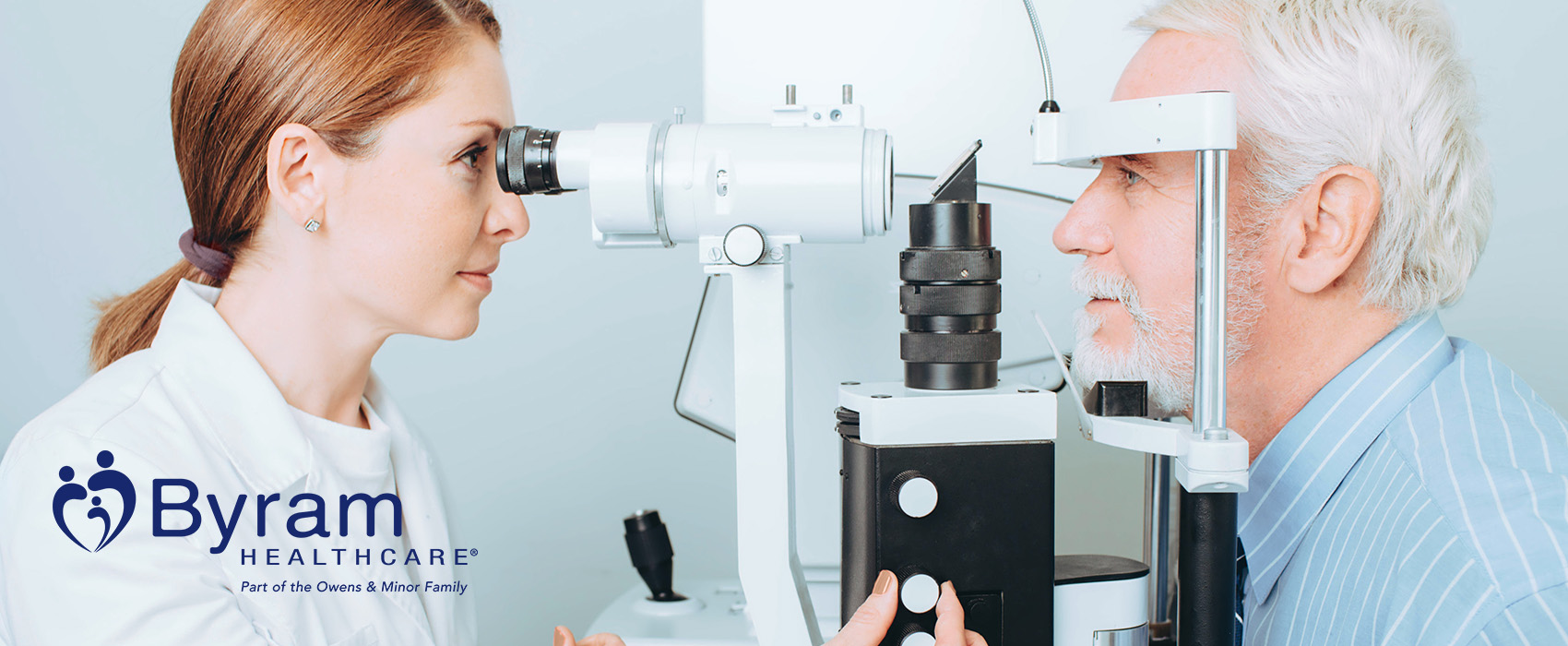
If you’re living with diabetes, you already know many of the effects it has on your body. Diabetes takes a toll on your organs and, when not managed properly, can lead to serious complications. One of these complications revolves around your eyes and your vision. Diabetic eye disease is most commonly associated with diabetic retinopathy, which is characterized by damage to the blood vessels of the retina and can lead to blindness. While living with diabetes doesn’t necessary guarantee that you’ll get diabetic retinopathy, it severely increases your risk. Symptoms fluctuate depending on your stage in the disease, so it’s important to regularly see your eye doctor to catch it early.
While there are many common diabetes myths, the relationship between the condition and your vision is true. People living with diabetes often suffer from vision loss or other eye conditions such as diabetic retinopathy. In this article, we’ll go over what you should know about diabetes and eye exams so you can take care of your vision and avoid long-term problems.
Understanding Diabetic Retinopathy
As we mentioned, diabetic retinopathy is a condition that develops when the blood vessels in your retina become damaged.1 The retina is the light-sensitive portion of the back of your eye and plays an important part in keeping images sharp, intense, and vivid. Diabetic retinopathy can affect people living with any type of diabetes and is generally related to the length of time since your diagnosis.
Symptoms of Diabetic Retinopathy
Early stages of diabetic retinopathy don’t necessarily cause symptoms, which is why eye exams are so important. Over time, as things worsen, you will likely experience one or more of the following symptoms:1
- Floaters, dots, or dark strings in your vision
- Dark or empty areas in your vision
- Blurry vision
- Difficulty focusing
- Vision changes that seem to fluctuate
- Altered color vision
- Partial or total vision loss
These symptoms can affect one eye at a time or both depending on the progression of the disease. If you experience any of these symptoms, see your doctor immediately.
Causes of Diabetic Retinopathy
The primary cause of diabetic retinopathy is the buildup of excess sugar in your bloodstream.1 The glucose gets to your eyes and can damage the microscopic vessels that supply blood to your retina.1 Over time, this buildup can even block the blood flow completely, which can lead to blindness. While temporary retinal damage doesn’t usually lead to blindness, the continual pressure over time is dangerous. Your eyes continually try to adapt to changing circumstances and therefore grow new blood vessels in an attempt to bypass the problem areas. These vessels tend to be more susceptible to damage and aren’t as strong or effective as your originals.1
Risk Factors for Diabetic Retinopathy
Some people are at a higher risk for developing diabetic retinopathy than others. Obviously, diabetes is the #1 risk factor. However, pregnancy, the length of time that you’ve had diabetes, and poor disease management can greatly increase your risk factors. Because of this, it’s important that it’s to use a continuous glucose monitor to keep track of your glucose levels throughout the day.
Certain medical conditions such as high blood pressure, heart disease, and high cholesterol also increase your risk for diabetic retinopathy.1 If you smoke you’re more likely to develop diabetic retinopathy and other diabetic complications, so try to find the strength, resources, and support to quit today.
To reduce your chances of diabetic retinopathy, make sure that you’re following a healthy diabetic meal plan and getting in the recommend amount of exercise. By staying healthy, you can greatly reduce your chances of developing diabetic retinopathy or other diabetic complications.
Different Types of Eye Care Providers
If you’re living with diabetes, it’s important to familiarize yourself with the different types of eye care providers. To make sure you’re staying proactive with the health of your eyes and vision, you should become familiar with most, if not all, of them at some point or another. There are opticians, optometrists, ophthalmologists, and retinal specialists.
- Opticians – these providers will be able to make glasses, lenses, and contact lenses for you that are fit to your prescription and eyesight.
- Optometrists – an optometrist is a healthcare professional that’s able to diagnose and treat certain types of eye conditions and diseases. They’re able to do the job of an optician.
- Ophthalmologists – this is a medical doctor who is capable and medically trained to diagnose and treat all types of eye diseases, including severe eye problems. Again, they’re also able to perform the job of an optician.
- Retinal Specialists – retinal specialists are ophthalmologists who specialize in problems with the retina.
Eye Exams for People with Diabetes
If you’re undergoing your first diabetic eye exam, it’s important to talk to your doctor about any questions or concerns you may have. While this may seem scary, it’s necessary to regularly see your ophthalmologist or optometrist to avoid serious, long-term complications. It’s recommended for people living with diabetes to get an eye exam every 1 to 2 years. If you can find an eye doctor who regularly treats people with diabetes, that’s even better. The American Diabetes Association (ADA) recommends that people with type 1 diabetes have their first eye exam within the first five years after diagnosis and people with type 2 diabetes have their first eye exam shortly after receiving a diagnosis.1
Dilated Retinal Exam
A dilated retinal exam allows your eye doctor to see the inside and back of your eye to look for certain eye problems and eye diseases. It’s usually done during regular eye exams and is important in early detection for diabetic retinopathy.
Optical Coherence Tomography (OCT)
An OCT provides images of your eyes so your doctor can see the fine details regarding the thickness of your retina and any potential fluid leaks.1 Your eye doctor will recommend an optical coherence tomography depending on your symptoms and risk factors. If you have any questions about getting an OCT, talk to your doctor today.
Fluorescein Angiography
A fluorescein angiography is when your doctor takes pictures of the inside of your eyes during a dilated retinal exam.1 After the pictures are taken, a special dye is injected into your arm that will travel through the blood vessels and into your eye. This dye helps your eye doctor identify which vessels have blockages and which vessels leak blood.1
Treating Eye Disease and Vision Loss
When caught early, there are plenty of options for treatment of diabetic retinopathy. One of the most effective medical treatments involves eye injections that help to prevent leaking blood vessels from worsening. There are also options for laser treatment that will prevent or reduce the progression of vision loss. However, for these treatment options to work properly, you need to catch it early and monitor progression. If you want to reduce your chances of developing diabetic retinopathy, proper diabetes management is key. Additionally, by managing your blood pressure and cholesterol levels, you can significantly reduce your chances of developing diabetic retinopathy and other diabetes related complications. Many times, when diabetes problems appear through eye damage, it’s an indication that damage is occurring in other areas of your body, so talk to your doctor about other preventative measures you can take to stay healthy and avoid complications. One of the best things you can do for yourself is exercise regularly, eat a diet that’s nutritious and filled with whole foods, and seek help if you’re experiencing any symptoms of diabetes distress.
Conclusion
Having diabetes means that you need to take certain precautions and commit to a healthy diabetes management. When managed poorly, you’re more likely to suffer from long-term complications like vision loss and diabetic retinopathy. To help you with your diabetes management, make sure you’re using a good blood glucose meter or continuous glucose monitoring device. If you’re not, Byram Healthcare has you covered. We’re proud to provide you with the latest technology in diabetes management, including continuous glucose monitoring. We’ll work with your insurance provider and doctor to ensure you’re supported from start to finish, maximizing your coverage while minimizing out-of-pocket expenses. For more information and added support on diabetes management, sign up for Byram Healthcare’s Caring Touch At Home™ Program. The Caring Touch At Home™ Program combines convenience, affordability, and choice to deliver extensive service and support to everyone living with diabetes.
Sources:
1 https://www.healthline.com/health/diabetes/diabetic-eye-exam#diagnosis




